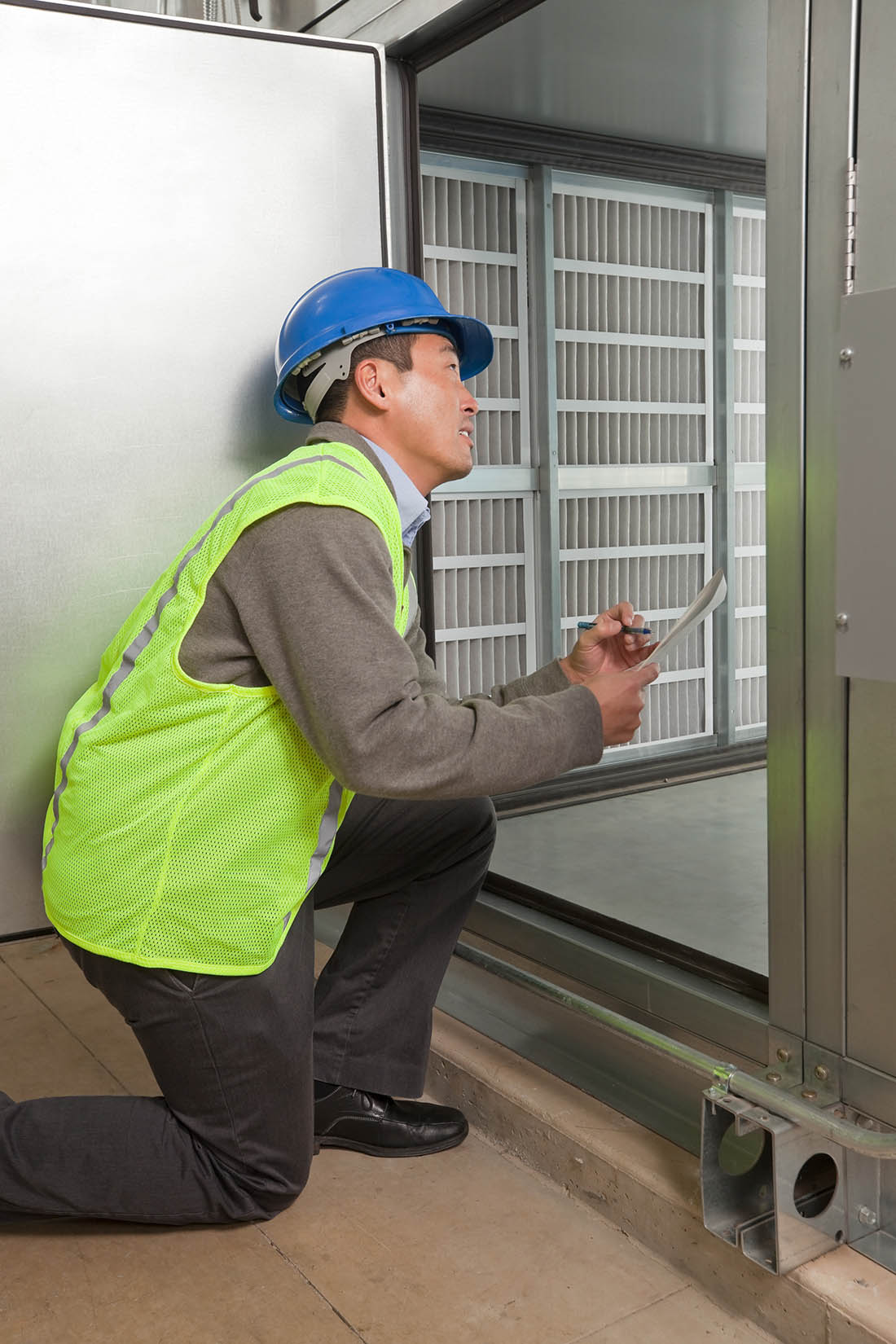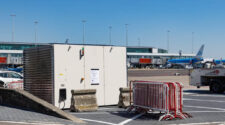Air filters are rated for how effective they are at removing a range of particles – from very small particles to larger particles that are visible to the human eye. The MERV rating for HVAC filters is an acronym for Minimum Efficiency Reporting Value. This rating is determined by filter manufactures in accordance with ASHRAE 52.2 – which is the method of testing general ventilation air-cleaning devices for removal efficiency by particle size.
Prior to the COVID pandemic, office building and residential air filtration was typically utilizing MERV 8- to MERV 10-rated filters. However, protection against certain airborne particulate, as well as the SARS CoV-2 virus, can be enhanced by including filters with higher MERV filtration rates. In light of the COVID-19 pandemic, the U.S. Centers for Disease Control and Prevention (CDC) is recommending the use of the highest efficiency filters as possible that do not compromise the overall effectiveness of the HVAC system.
Filtration is only one aspect of indoor air quality. The four basic factors that influence indoor air quality are: 1. buildings occupants; 2. pollution pathways; 3. other sources of contamination; and 4. the HVAC system. There are many variables within the HVAC system itself, including personal activity levels, uniformity of temperature, humidity, ventilation and air exchange. The HVAC system design and operation are at the heart of indoor air quality control. A properly balanced system isolates and removes contaminates through pressure control, filtration and exhaust.
The MERV 13 factor
MERV 13 is not the highest-rated filter available, but it is the filter rating that has risen to the forefront as the CDC has recommended the use of high-efficiency filters in response to the pandemic. The MERV scale rates filters from MERV 1- 20. The higher the number, the higher the efficiency over a range of particle sizes. Having a filter that is rated a MERV 13 or higher has a removal efficiency in the 0.30 – 1.0 micron, ranging from 50% to 95%. The bioaerosol particle size range that contains viruses, including corona viruses, is within this typically range. Installing a MERV 10 or less filter – as was typically the case in commercial and residential systems prior to the pandemic – has no effect on particulates in the 0.30 – 1.0-micron size range.
There are some complications relating to the installation of MERV 13 filters in systems with 1” and 2” filter racks, as MERV 13 filters are typically deeper to minimize pressure drop. A basic switch to a MERV 13 from a lower-rated filter in a 1” or 2” system presents unintended consequences, which result in a cascade of increases within the HVAC system. These manifest in higher resistance, increased pressure, as well as increases in energy use in the system. This can cause airflow reductions, freezing of the air conditioner coil and, potentially, damage to the compressor. A workaround could be to retrofit a larger rack to accommodate a deeper filter with significantly more filtration media. This is not a simple or cheap task. Cost is not the only factor though, as a retrofit would also require steps to ensure the enlarged filter rack is as airtight as possible to prevent air bypass or depressurization effects from occurring.
High-efficiency filtration operating considerations
After higher-rated filters are installed and operating, they should be monitored and maintained to provide maximum filtration, while not overworking the supply fan. Overloading the fan can lead to filter “blow-out” situations, which leads to virtually no air filtration. To help automate this, a differential-pressure measurement device can be installed across the filter bank to identify the appropriate change-out times. Also, pressure drop switches may be used to provide an alarm input to a Building Automation System that alerts operators to change the filter. With the internet of things (IOT), this technology is also becoming more accessible to residential applications.
Bonus ’Tech Talk’ Video
Learn More @ inda.org/education!
With high-efficiency filters, it is difficult to rely on a visual inspection alone, since medium- and high-efficiency filters that appear “dirty” often have not reached their optimum efficiency levels due to depth loading. As a filter loads up with particles, it becomes more efficient at particle removal, but increases pressure drop through the system, thus reducing airflow and consuming more energy. All filters when loaded to excess will become misshapen, unload filtered dust, and even, as mentioned above, “blow out” of their filter rack. When filters blow out, bypass of unfiltered air can quickly lead to problems such as clogged coils and dirty air ducts and, potentially, a large influx of captured bioaerosol particulate.
As a rule, it is safe to presume that all filters may have active microbiological materials on or within a filter. These materials may be pathogenic or not, but the risk during the pandemic has heightened the awareness and precautionary procedures are even more important today.
When changing out filters – especially when there are known cases of any infectious disease such as COVID-19 – personal protective equipment is a must. It is good practice to change filters with the system turned off while specifically wearing gloves, eye protection and a properly fitted respirator with N95 or higher rating. When feasible, the filter should be disinfected with a 10% bleach solution or other disinfectant suitable for the task and placed and sealed in a bag prior to disposal.
Other factors
HVAC filtration can be augmented by a number of additional control elements to clean pollutants and contaminants out of the air. When used properly, ultraviolet light, room air cleaners and humidity control can be part of a plan to reduce the potential for airborne transmission of COVID-19 indoors. Ultraviolet light purifiers utilize short-wave UV-C light to inactivate airborne pathogens and microorganisms. As air is forced through the device, it passes over UV lamps, which disinfects via irradiation.
Portable room air cleaners (or scrubbers), typically allow for more air exchanges, and also provide a visual cue for people to help them know they are being protected.
Humidity control is also an important consideration, as it ties the system and augmentations together. Viruses and bacteria prefer extremes of very dry or very moist conditions. Maintaining a balanced relative humidity between 40% – 60% will help minimize.
One interesting technology that is being prototyped for commercial use in HVAC systems is Air Plasma. APJeT is an advanced technology company located in the Research Triangle Park, in Morrisville, North Carolina. Initial testing results of this technology show a 99.9999% (6-log) kill rate on a human coronavirus (a COVID-19 surrogate). By comparison, UV-C shows a 99.9% (3-log) kill rate, as stated on the International Ultraviolet Association website. (www.iuva.org/iuva-covid-19-faq). This is one of many new technologies being developed and integrated into the marketplace to help improve indoor air quality, and technology development in this area figures to be prolific in the months to come.
The new normal
I see indoor filtration at MERV 13 levels as the new minimum normal for filtration systems going forward. Just prior to the pandemic, California enacted the “Title 24” Energy Code, which requires this level of filtration for all construction and renovation. This is being adopted by many states and is quickly becoming defacto. This is also being recommended by the American Society of Heating, Refrigeration and Air-Conditioning Engineers (ASHRAE), and the U.S. Environmental Protection Agency and the CDC.
The COVID-19 pandemic has significantly educated the public about indoor air quality, and with many upgrades and new laws being enacted or proposed, it looks like we will be getting a breath of clean, fresh air long into the future.
As director of education and technical affairs, Chris presents regular training related to nonwovens and filter media from INDA’s headquarters in Cary, NC. For more information about upcoming training opportunities, visit inda.org/education.
* International Filtration News is owned by INDA, Association of the Nonwoven Fabrics Industry (inda.org).










